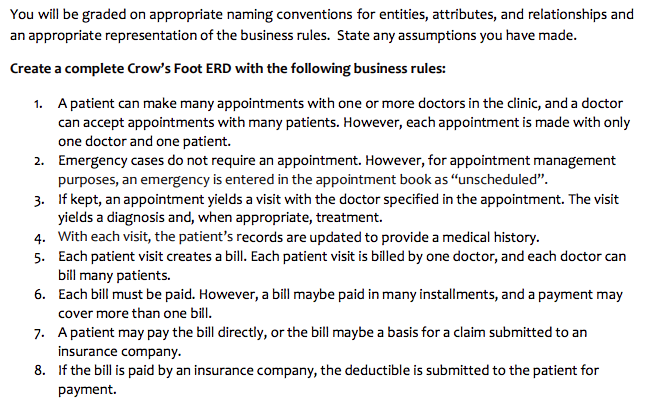

Review the scenario and business rules provided and draw a Crow's foot ERD. nstructions for the ERDs: 1. List the entities AND attributes 2. Show the relationships, connectivity, AND cardinality. Be sure to label all relationships 3. Convert all M:N relationships using composite entities 4. Identify the primary key(s) in each entity. (underline with solid line or notate with PK indicator). Place foreign keys as necessary and notate the foreign key (underline with dotted line or notate with FK indicator) Include all other extended ER modeling notations as necessary All attributes should be single valued attributes Use proper naming conventions for entities and attributes. Copy and paste your ERD into a Word or PDF document. Save the document and upload using the assignment link provided in eLearning. 5. 6. 7. 8. 9. You will be graded on appropriate naming conventions for entities, attributes, and relationships and an appropriate representation of the business rules. State any assumptions you have made Create a complete Crow's Foot ERD with the following business rules: A patient can make many appointments with one or more doctors in the clinic, and a doctor can accept appointments with many patients. However, each appointment is made with only one doctor and one patient. Emergency cases do not require an appointment. However, for appointment management purposes, an emergency is entered in the appointment book as "unscheduled". If kept, an appointment yields a visit with the doctor specified in the appointment. The visit yields a diagnosis and, when appropriate, treatment. With each visit, the patient's records are updated to provide a medical history 1. 2. 3. 4. 5. Each patient visit creates a bill. Each patient visit is billed by one doctor, and each doctor can 6. Each bil must be paid. However, a bill maybe paid in many installments, and a payment may 7. A patient may pay the bill directly, or the bill maybe a basis for a claim submitted to an 8. If the bill is paid by an insurance company, the deductible is submitted to the patient for bill many patients. cover more than one bill insurance company payment. Review the scenario and business rules provided and draw a Crow's foot ERD. nstructions for the ERDs: 1. List the entities AND attributes 2. Show the relationships, connectivity, AND cardinality. Be sure to label all relationships 3. Convert all M:N relationships using composite entities 4. Identify the primary key(s) in each entity. (underline with solid line or notate with PK indicator). Place foreign keys as necessary and notate the foreign key (underline with dotted line or notate with FK indicator) Include all other extended ER modeling notations as necessary All attributes should be single valued attributes Use proper naming conventions for entities and attributes. Copy and paste your ERD into a Word or PDF document. Save the document and upload using the assignment link provided in eLearning. 5. 6. 7. 8. 9. You will be graded on appropriate naming conventions for entities, attributes, and relationships and an appropriate representation of the business rules. State any assumptions you have made Create a complete Crow's Foot ERD with the following business rules: A patient can make many appointments with one or more doctors in the clinic, and a doctor can accept appointments with many patients. However, each appointment is made with only one doctor and one patient. Emergency cases do not require an appointment. However, for appointment management purposes, an emergency is entered in the appointment book as "unscheduled". If kept, an appointment yields a visit with the doctor specified in the appointment. The visit yields a diagnosis and, when appropriate, treatment. With each visit, the patient's records are updated to provide a medical history 1. 2. 3. 4. 5. Each patient visit creates a bill. Each patient visit is billed by one doctor, and each doctor can 6. Each bil must be paid. However, a bill maybe paid in many installments, and a payment may 7. A patient may pay the bill directly, or the bill maybe a basis for a claim submitted to an 8. If the bill is paid by an insurance company, the deductible is submitted to the patient for bill many patients. cover more than one bill insurance company payment








